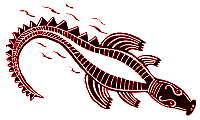| |
|
|
 An Education Kit
for Grades 5 - 7 An Education Kit
for Grades 5 - 7
|

|
| What you need |
| |
 |
Croc Features Information Sheet (class set) |
| |
 |
large sheets of butcher's paper |
| |
 |
coloured pens and pencils |
| |
 |
examples of reports on animals (e.g. Sloan, 1989) |
| |
|
|
|
Activities for
teachers |
Summary |
|
KLAs |
| a Random fact sheets |
Construct random fact sheets using information already known about crocs |
 |
English |
| b Deconstruct report |
Read text, deconstruct text to establish report format |
English |
| c Colour Coding |
Colour code related pieces of information from random fact sheet |
Eng SoSE
Sci |
| d Report construction |
Construct group negotiated report |
Eng SoSE |
| Information Sheet on the habitat, distribution, evolution and adaptations of estuarine crocs. |
|
|
|
| What you do |
|

|
| |
|
|
a) Random fact sheet
- Brainstorm what students already know about crocs.
- Record the facts in point form or note form on butchers paper using the random fact sheet format shown below. Display the results in the classroom.
- Read the Croc Features Information Sheet either in groups or as a whole class and add additional information to the random fact sheets.
- Use other resources such as books from your library to gain additional information about crocs and add further details to the random fact sheets. It is important not to add too much detail to the sheets as this can complicate the following activities.
|
|
|
b) Deconstruct report
- Ask students to read the Croc Features Information Sheet again, looking at individual paragraphs and to suggest possible sub- headings for each paragraph, eg. distribution, habitat, etc.
- Provide students with copies of other reports on animals such as Animal Reports by Sloan and repeat the process.
- Develop a format for a report and display it in the classroom.
|
| Report |
Classification
(what it is) |
|
Sub-headings
(text written in paragraphs) |
|
| Summary or conclusion |
|
|
|
|
c) Colour coding
- Ask students to look closely at the information on the random fact sheet and locate bits of information which are related to each other. For example, there may be several notes on size and physical features of crocs and several others on behaviour.
- Use coloured pens to circle related bits of information in the same colour. Ask students to suggest headings (taken from the report format) that describe the different groups of information.
d) Report construction
- Work as a group or a whole class to construct paragraphs using the information in one particular group (colour). You may need to do a reasonable amount of teacher modelling if students are not familiar with report construction. For example, you may need to construct 2 or 3 paragraphs before students in groups can construct their own, using the remaining information.
- Discuss with students the order in which the paragraphs are to be presented and refer them back to the report format already developed. Reports should begin with a definition and this is best constructed on a whole class basis.
- Display the report in the classroom for future reference.
Extension:
- Compare the features of crocs with other familiar reptiles such as geckos or lizards, looking at features that are characteristic of reptiles and suggest how each reptile is adapted to its particular environment. Pose questions, ie. how does a gecko keep its tail on the ceiling? or how does a snake grow when its scaley skin gets 'too tight'?
- Involve students in problem-solving activities, either class discussion or individual projects, by posing questions such as "Would a croc survive in Sydney? Why or why not?"
- Discuss what is meant by 'top predator' and ask students to use their understanding of adaptations to design a super-creature with features that would enable it to prey on the estuarine croc.
|
 |
© Copyright 2000
Marine Education Society of Australasia
Wildlife Preservation Society of Qld |
 |
croc relationships |
|
|
|
|
|